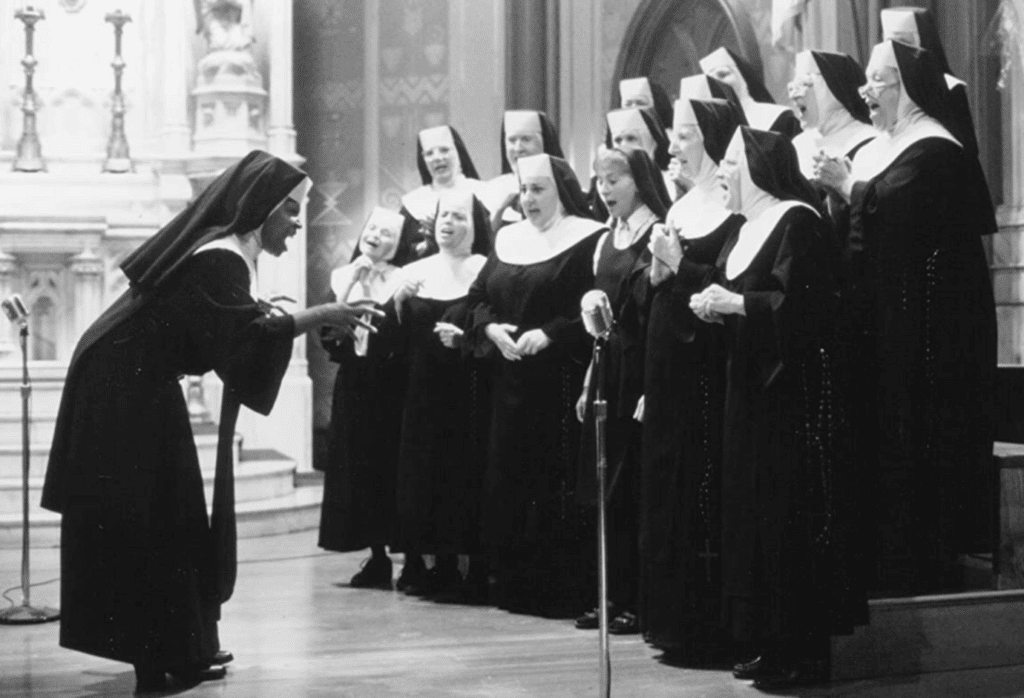Jessie Tu is reviewing the classics of the 1990s to see how they stand up today. Below, she rewatches the 1992 Whoopi Goldberg hit, Sister Act.
It’s been thirty-one years since the world first saw Whoopi Goldberg jam herself and her wondrous big hair into a nun’s habit. “Sister Act” is a movie about women caring for other women. It’s a rare classic that leans on the individual and collective kindness of women. It’s also one of the best queer films of the 90s.
It’s not nasty, cruel, jealous or diminishing. Its director, Emile Ardolino, wasn’t setting out to prove anything. [He didn’t need to — he made “Dirty Dancing” just four years prior, and then “Three Men and a Little Lady” in 1990.]
Such was my relief when I rewatched it again last week, re-living the colossal comfort of the Motown medley during the opening credits. The nostalgia of seeing Whoopi in her glittering golden gown singing clipped renditions of the 60s classics (“Heat Wave”, “My Guy”, “I will follow him”) — was like inhaling pure happiness.
There is nothing quite as soothing and homey as Goldberg’s wry, wincing disgruntlement.
She plays Deloris Van Cartier, a self-made entertainer who is about to quit her job as the leader of a Supremes-eque trio at the Moonlight Lounge in Reno, Nevada. She’s unsatisfied with her career and her love life has hit a dead end.
When she goes to break up with her lover — Vince LaRocca (played by Harvey Keitel, whose face proves he was born to play a gangster) Deloris witnesses a murder and runs from the scene.
A Black cop offers to help her by keeping her safe in the last place Vince and his men will think to find her — a convent. In San Francisco. She needs to stay there, like jail, because Vince has a $US250,000 hit on her.
The moment Deloris enters Saint Katherine’s Church and puts on her new uniform, we’re waiting for that big hair of her’s to come out again. (Thankfully, it does.) She was born Deloris Wilson, became Deloris Van Cartier, and is now Sister Mary Clarence. Here is a woman who has re-imagined herself in order to do what she loves (sing and perform) and now has to take on yet another identity, this time, surrounded by white women.
Enter Maggie Smith, the Mother Superior – the head nun. She is Madeline’s dear teacher, Miss Clavel, an expression of worry and deep concern permanently etched on her face.
“God has brought you here,” she tells Deloris, “You will sing and you will sleep. That will be your task.”
As the new director of the choir, Deloris injects some joy and pizzazz into the stale religiosity of the convent.
“People like going to the theatre and casino, they don’t like going to church!” she instructs Mother Superior. “We can change things…we can pack this joint! Sister, we can rock this place!”
Which brings me to the spiritual core of this film — the classic, incomparable musical numbers. I can’t think of another movie (minus musicals) that has such an iconic soundtrack stamped on it.
A rollicking cast of splendid characters fill the screen for the next hour — Sister Mary Patrick, played by Kathy Najimy, is the funniest of them all – she is large, loud and playful. Her energy radiates off the screen. Everything about her – the way she moves, the way she talks, the way she sings – is big, bold and boisterous.
Offsetting her invulnerability is Wendy Makkena, who plays the sweet redhead with that iconic fringe, Mary Robert. She always appears to be on the verge of tears.
And of course, how can we not mention the repressed sexuality she exudes so strongly on screen. (Nuns and queer cult status? How can we not think of this film’s ideological adjacency to “The Sound of Music” and its stardom among the queer community?)
Remember that tender scene where she knocks on Deloris’ door one night and comes in (and shuts the door behind her) and gifts her daisy alarm clock?
She sits on Deloris’ bed, and, unsolicited, opens up emotionally: “I’ve always felt that there’s something inside me, that I want to give. Something that’s only me, and nobody else.”
Erm, you mean, your love of women?
“You know how sometimes it’s as if you have to be yourself or you’ll just burst?” she continues, her face open and exuberant for the first time since we meet her.
This is the most sexually charged scene in the film, though as a child, I couldn’t read it. I just thought it was a scene about two women connecting (which it is, too).
There is also something beautiful (and extremely sexual) about the way Deloris presses her hands on Sister Mary Robert’s abdomen during her first choir rehearsal, quivering as she applies pressure on her belt, and rejoicing as the docile woman finds a new vitality to her voice.
All the women gasp, their faces stirred with quiet ecstasy.
Beyond that, their first performance under the guidance of Sister Mary Clarence, singing “Hail, Holy Queen” is still one of my favourite cinematic musical numbers — I was moved to the point of tears watching it recently. There is something unnameable yet profound about that scene, and it has something to do with the universal power of singing, of music, and the complete race-blindness the film has with its female lead.
Deloris/Sister Mary Clarence is Black, but nobody cares. No one ostracises her for her race. It’s a fantasy world that made me believe in a kind and fair society when I was a child. Perhaps that’s why the film is still so comforting to watch, and those scenes of them singing together, brought together for their shared love of singing — so incredibly moving.
The stakes become no longer about Deloris’ wellbeing, but the wellbeing of the nuns and whether they will come out of their shells.
All the white women in this film are repressed (we don’t see their hair) and Deloris is trying to reenergise them. It’s the closeted white person vs. gregarious Black person trope we have seen in countless films including “Ghost” (1990) and “Bringing Down the House” (2003).
When an opportunity to sing before the Pope arises, her loyalties with the choir clash with her own safety. Vince’s men have located her, but he doesn’t know she’s made some strong friends in a group of nuns. They exercise their charm by morally blackmailing a helicopter pilot to fly them all to Reno to save their friend.
And they do! Here is a group of women, willing to put their lives in danger for another woman, not related to them — the ultimate and most under-recognised relationship in art — that of friendship (though for Sister Mary Robert, is definitely romantic love for Sister Mary Clarence).
“We’ve got to save her,” she cries to Mother Superior.” Another sister adds, “We can’t leave it up to the Feds!” (ie. we can’t leave it up to men).
The final musical number, “I will follow Him”, which is performed to a packed church with the Pope in the audience, Sister Mary Robert is singing like she belongs in the Moonlight Lounge in Reno, and Sister Mary Clarence has let out her hair.
The whole film works up to this one, critical resolve. The hair represents Deloris, coming into herself, getting what she’s always wanted — acceptance, love, appreciation for her talent as a singer, and a crowd full of people celebrating her womanhood. The camera lingers on every nun’s face. It cares about them, and is interested in honouring their new charge for life.
“This is not a satire, it’s not an attempt to put the church down,” the film’s director Emile Ardolino said in a special behind the scenes video. “This is a good natured, good-humoured view of nuns, but we explore them more as people, rather than as Catholics.”
It’s strange to imagine anyone else playing the part of Deloris / Sister Mary Clarence, but Bette Midler was initially tipped for this role.
When she turned it down, the producers gave the part to Goldberg. And thank God. Though Midler would have done a fine job in the role (she has the same wry, anarchic energy as Goldberg) it just wouldn’t have been the same. There’s a comforting race blindness to the film that, as a child, made me believe in a world where a Black woman could be in a leadership role, and for that to be totally and utterly unremarkable.
Look out for our take on “Sister Act 2” (1993) next week. In the meantime, we’re looking forward to the day Sister Act 3 is in the works.
Image credit: Touchstone Pictures (Sister Act, 1992)


